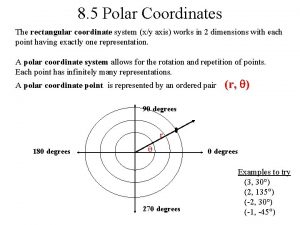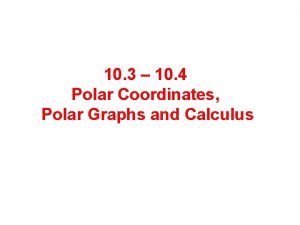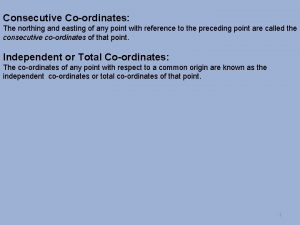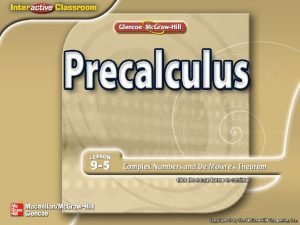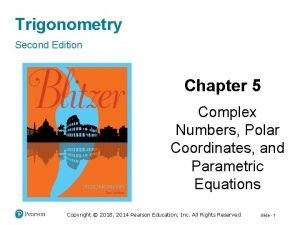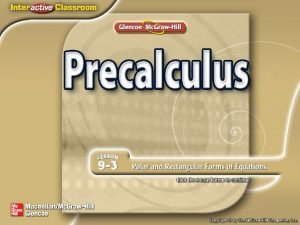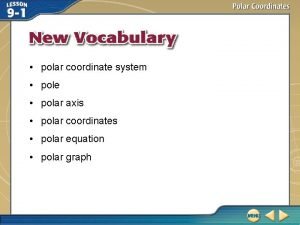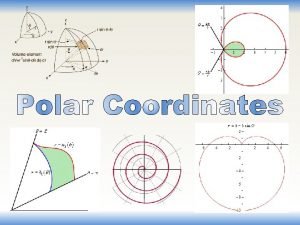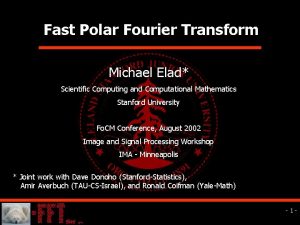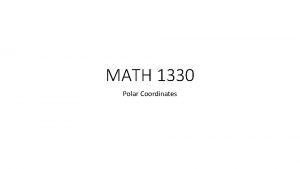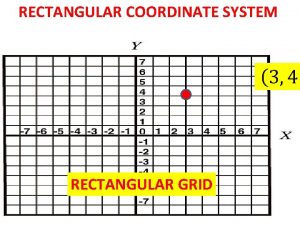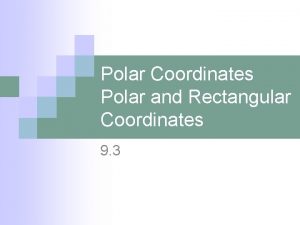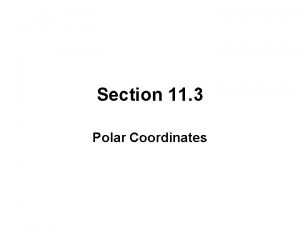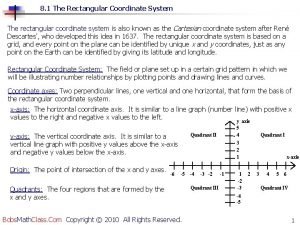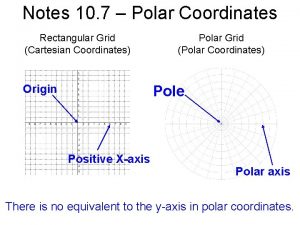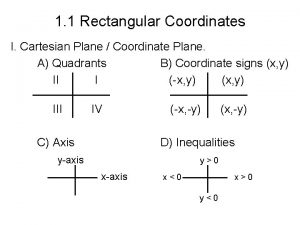8 5 Polar Coordinates The rectangular coordinate system














- Slides: 14

8. 5 Polar Coordinates The rectangular coordinate system (x/y axis) works in 2 dimensions with each point having exactly one representation. A polar coordinate system allows for the rotation and repetition of points. Each point has infinitely many representations. A polar coordinate point is represented by an ordered pair (r, ) 90 degrees r 180 degrees 270 degrees Examples to try (3, 30°) (2, 135 ) (-2, 30°) (-1, -45 )

Converting Coordinates: Polar to/from Rectangular 90 degrees P(x, y) r 180 degrees Example: Polar to Rectangular Point: (2, 30º) X = 2 cos 30 = 3 Y = 2 sin 30 = 1 Rectangular point: ( 3 , 1) x y 0 degrees Example: Rectangular to Polar Rextangular Point: (3, 5) 32 + 52 = r 2 r = 34 x tan = 5/3 = 59º Polar point: ( 34 , 59º) = r cos y = r sin x 2 + y 2 = r 2 Note: You can also convert rectangular Equations to polar equations and vice versa. tan = y x

Rectangular vs Polar Equations Rectangular equations are written in x and y Polar equations are written with variables r and x = r cos y = r sin x 2 + y 2 = r 2 tan = y Rectangular equations can be written in an equivalent polar form x Example 1: Convert y = x - 3 (equation of a line) to polar form. x–y=3 (r cos ) – (r sin ) = 3 r (cos - sin ) = 3 r = 3/(cos - sin ) Example 2: Convert x 2 + y 2 = 4 (equation of circle) to polar form r 2 = 4 r = 2 or r = -2

Rectangular vs Polar Equations Rectangular equations are written in x and y Polar equations are written with variables r and x = r cos y = r sin x 2 + y 2 = r 2 tan = y x Polar equations can be written in an equivalent rectangular form Example 1: Convert to rectangular form. r + rsinθ = 4 r+y=4=3 x 2 + y 2 = (4 – y)2 x 2 = -y 2 + 16 -8 y + y 2 x 2 = 16 -8 y x 2 – 16 = -8 y y = - (1/8) x 2 + 2

Graphing Polar Equations To Graph a polar equation, Make a / r chart for until a pattern apppears. Then join the points with a smooth curve. Example: r = 3 cos 2 (4 leaved rose) 90 degrees r 0 15 30 45 60 75 90 3 2. 6 1. 5 0 -1. 5 -2. 6 -3 180 degrees 270 degrees P. 387 in your text shows various types of polar graphs and associated equation forms.

Graphing Polar Equations To Graph a polar equation, Make a / r chart for until a pattern apppears. Then join the points with a smooth curve. Example: r = 3 cos 2 (4 leaved rose) r 0 15 30 45 60 75 90 3 2. 6 1. 5 0 -1. 5 -2. 6 -3 P. 387 in your text shows various types of polar graphs and associated equation forms.

Classifying Polar Equations • Circles and Lemniscates • Limaçons • Rose Curves 2 n leaves if n is even n ≥ 2 and n leaves if n is odd

8. 6 Parametric Equations are sometimes used to simulate ‘motion’ x = f(x) and y = g(t) are parametric equations with parameter, t when they Define a plane curve with a set of points (x, y) on an interval I. Example: Let x = t 2 and y = 2 t + 3 for t in the interval [-3, 3] Graph these equations by making a Convert to rectangular form by t/x/y chart, then graphing points (x, y) Eliminating the parameter ‘t’ T x y Step 1: Solve 1 equation for t -3 9 -3 Step 2: Substitute ‘t’ into the -2 4 -1 ‘other’ equation -1 1 1 0 0 3 Y = 2 t + 3 t = (y – 3)/2 1 1 5 2 4 7 2 X = ((y – 3)/2) 3 9 9 X = (y – 3)2 4

Application: Toy Rocket • A toy rocket is launched from the ground with velocity 36 feet per second at an angle of 45° with the ground. Find the rectangular equation that models this path. What type of path does the rocket follow? The motion of a projectile (neglecting air resistance) can be modeled by for t in [0, k]. Since the rocket is launched from the ground, h = 0. The parametric equations determined by the toy rocket are Substitute from Equation 1 into equation 2: A Parabolic Path

8. 2 & 8. 3 Complex Numbers Graphing Complex Numbers: • Use x-axis as ‘real’ part • Use y-axis as ‘imaginary’ part Trig/Polar Form of Complex Numbers: • Rectangular form: a + bi • Polar form: r (cos + isin ) are any two complex numbers, then Product Rule Quotient Rule

Examples of Polar Form Complex Numbers Trig/Polar Form of Complex Numbers: • Rectangular form: a + bi • Polar form: r (cos + isin ) Example 1: Express 10(cos 135° + i sin 135°) in rectangular form. Example 2: Write 8 – 8 i in trigonometric form. The reference angle Is 45 degrees so θ = 315 degrees.

Product Rule Example from your book Find the product of 4(cos 120° + i sin 120°) and 5(cos 30° + i sin 30°). Write the result in rectangular form. Product Rule

Quotient Rule Example from your Book • Find the quotient Note: CIS 45◦ is an abbreviation For (cos 45◦+ isin 45◦) Quotient Rule

8. 4 De Moivre’s Theorem is a complex number, then Example: Find (1 + i 3)8 and express the result in rectangular form 1 st, express in Trig Form: 1 + i 3 = 2(cos 60 + i sin 60) Now apply De Moivre’s Theorem: 480° and 120° are coterminal. Rectangular form
 Polar coordinates physics
Polar coordinates physics Rectangular vs polar coordinates
Rectangular vs polar coordinates Polar and rectangular forms of equations
Polar and rectangular forms of equations Rectangular and polar coordinates
Rectangular and polar coordinates Consecutive and independent coordinates in surveying
Consecutive and independent coordinates in surveying Dot product properties
Dot product properties Find the rectangular coordinates of the point
Find the rectangular coordinates of the point How to find polar coordinates
How to find polar coordinates Find the rectangular coordinates of the point . a. c. b. d.
Find the rectangular coordinates of the point . a. c. b. d. Pole in polar coordinates
Pole in polar coordinates Polar axis and pole
Polar axis and pole Polar graph project
Polar graph project Line in polar coordinates
Line in polar coordinates Geodesic polar coordinates
Geodesic polar coordinates Polar fft
Polar fft

